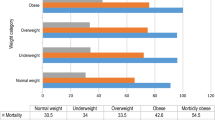Abstract
Purpose
This study aims to examine the predictive role of obesity-type-related indexes and perioperative intraabdominal pressure measurements for early postoperative complications following bariatric surgery.
Materials and Methods
Sixty-seven female patients with obesity who underwent bariatric surgery (laparoscopic sleeve gastrectomy or gastric bypass) were included in this study. Obesity-related indexes (BMI, waist/hip ratio, and waist/height ratio) were calculated using patient data. Intraoperative hemodynamic measurements and intraabdominal pressure measurements were done at the beginning and at the end of the operation. Intraabdominal pressure measurements were done using both bladder port and trocar port. Patients were followed for early postoperative complications.
Results
Among 67 patients included, 22 developed early postoperative complications (32.8%), mostly pulmonary (20.9%). Trans-trocar IAP measured at the beginning of the operation emerged as the single independent predictor of postoperative complications (OR, 40.3; p = 0.002). Based on ROC analysis, AUC for predicting complications was 0.955 (p < 0.01). Optimal cutoff point (≥ 14.5 mmHg) was associated with 100% sensitivity and 82% specificity. In addition, there were weak but significant positive correlations between trans-trocar IAP-beginning and BMI (r = 0.443, p < 0.001), waist/hip ratio (r = 0.434, p < 0.001), and waist/height ratio (r = 0.539, p < 0.001).
Conclusion
Findings of this study suggest that a high baseline intraabdominal pressure predicts a higher risk for early postoperative complications following bariatric surgery. This information would help improve patient care. Further large studies are warranted.
Graphical abstract


Similar content being viewed by others
References
Bray GA, Heisel WE, Afshin A, et al. The science of obesity management: an endocrine society scientific statement. Endocr Rev. 2018;39:79–132.
Flegal KM, Kruszon-Moran D, Carroll MD, et al. Trends in obesity among adults in the United States, 2005 to 2014. JAMA. 2016;315:2284–91.
Thorell A, MacCormick AD, Awad S, et al. Guidelines for perioperative care in bariatric surgery: enhanced recovery after surgery (ERAS) society recommendations. World J Surg. 2016;40:2065–83.
Frezza EE, Reddy S, Gee LL, et al. Complications after sleeve gastrectomy for morbid obesity. Obes Surg. 2009;19:684–7.
Frezza EE, Shebani KO, Robertson J, et al. Morbid obesity causes chronic increase of intraabdominal pressure. Dig Dis Sci. 2007;52:1038–41.
Varela JE, Hinojosa M, Nguyen N. Correlations between intra-abdominal pressure and obesity-related co-morbidities. Surg Obes Relat Dis. 2009;5:524–8.
Lambert DM, Marceau S, Forse RA. Intra-abdominal pressure in the morbidly obese. Obes Surg. 2005;15:1225–32.
Nguyen NT, Lee SL, Anderson JT, et al. Evaluation of intra-abdominal pressure after laparoscopic and open gastric bypass. Obes Surg. 2001;11:40–5.
Dindo D, Demartines N, Clavien PA. Classification of surgical complications: a new proposal with evaluation in a cohort of 6336 patients and results of a survey. Ann Surg. 2004;240:205–13.
Sugerman HJ. Effects of increased intra-abdominal pressure in severe obesity. Surg Clin North Am. 2001;81(1063–75):vi.
Sugerman HJ. Comment on: Correlations between intra-abdominal pressure and obesity-related co-morbidities. Surg Obes Relat Dis. 2009;5:528–9.
Wilson A, Longhi J, Goldman C, et al. Intra-abdominal pressure and the morbidly obese patients: the effect of body mass index. J Trauma. 2010;69:78–83.
Harman PK, Kron IL, McLachlan HD, et al. Elevated intra-abdominal pressure and renal function. Ann Surg. 1982;196:594–7.
Bloomfield GL, Ridings PC, Blocher CR, et al. A proposed relationship between increased intra-abdominal, intrathoracic, and intracranial pressure. Crit Care Med. 1997;25:496–503.
Diebel LN, Dulchavsky SA, Brown WJ. Splanchnic ischemia and bacterial translocation in the abdominal compartment syndrome. J Trauma. 1997;43:852–5.
Nathens AB, Brenneman FD, Boulanger BR. The abdominal compartment syndrome. Can J Surg. 1997;40:254–8.
Richardson JD, Trinkle JK. Hemodynamic and respiratory alterations with increased intra-abdominal pressure. J Surg Res. 1976;20:401–4.
Gero D, Raptis DA, Vleeschouwers W, et al. Defining global benchmarks in bariatric surgery: a retrospective multicenter analysis of minimally invasive Roux-en-Y gastric bypass and sleeve gastrectomy. Ann Surg. 2019;270:859–67.
Todurov IM, Bilians'kyi LS, Perekhristenko OV, et al. The factor of intra-abdominal pressure in patients with morbid obesity. Klin Khir. 2013;5:28–31. (Article in Ukrainian language).
Talisman R, Kaplan B, Haik J, et al. Measuring alterations in intra-abdominal pressure during abdominoplasty as a predictive value for possible postoperative complications. Aesthetic Plast Surg. 2002;26:189–92.
Author information
Authors and Affiliations
Corresponding author
Ethics declarations
Ethics Approval
All procedures performed in this study were in accordance with the ethical standards of the institutional and/or national research committee and with the 1964 Helsinki declaration and its later amendments or comparable ethical standards.
Informed Consent
Informed consent was obtained from all individual participants included in the study.
Conflict of Interest
The authors declare no competing interests.
Additional information
Publisher's Note
Springer Nature remains neutral with regard to jurisdictional claims in published maps and institutional affiliations.
Key Points
Obesity is associated with increased intraabdominal pressure.
Bariatric surgery may occasionally be associated with obesity-related complications.
Intraabdominal pressure predicts early postoperative complications.
This may aid in early identification of patients at risk and improve patient care.
Supplementary Information
Below is the link to the electronic supplementary material.
Supplementary file1 (MP4 103040 KB) Supplementary video. Preparation of trocar site, placement of trocar, and trans trocar pressure measurement. The trocar entrance site is manually (digitally) checked by the surgeon to assure absence of obstruction. Trocar is placed and patency is checked with video image prior to the pressure measurements. Intraabdominal pressure measurement is made using pressure probe (arterial transducer)
Rights and permissions
About this article
Cite this article
Zengin, S.U., Orhon Ergun, M. & Gunal, O. The Effects of Perioperative Factors on Early Postoperative Morbidity in Bariatric Surgery. OBES SURG 32, 1236–1242 (2022). https://doi.org/10.1007/s11695-022-05931-2
Received:
Revised:
Accepted:
Published:
Issue Date:
DOI: https://doi.org/10.1007/s11695-022-05931-2




